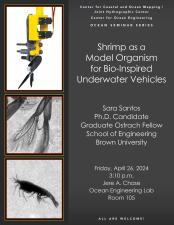Shrimp as a Model Organism for Bio-Inspired Underwater Vehicles
Dept. of Engineering
Brown University
Metachronal locomotion is present across a wide range of length scales and Reynolds numbers, from the micron-sized paramecium to the meter-sized lobster. Metachronal, drag-based swimming in shrimp has been studied to understand its ecological significance and to find engineering solutions for underwater locomotion. Shrimp display incredible maneuverability at intermediate Reynolds numbers (Re), skills lacking in current uncrewed underwater vehicles. We investigate individual characteristics of their kinematics and morphology to gain a comprehensive understanding of their methods for success. Using a scaled-up robotic appendage that integrates the kinematic and morphological characteristics of Palaemon paludosus, such as the cupping of propulsors, we untangle the influence of different dynamic interactions on the near- and far-field flow produced during shrimp swimming. We perform kinematics, force, and particle image velocimetry measurements to understand the generation of thrust and lift, the formation of vortices due to the fluid-structure interactions, and overall hydrodynamics. This approach allows us to identify the mechanisms of success in shrimp swimming, evaluate their role in overall performance, and optimize the design of bio-inspired underwater robots to perform tasks requiring different skills. Our tools enable varied configurations and customization, appealing to various disciplines to serve as a platform for understanding marine animals' biology, ecology, and engineering.
Sara Santos is a Ph.D. candidate and Graduate Ostrach fellow at the School of Engineering at Brown University doing interdisciplinary work in fluid mechanics, biology, and ecology. She holds an M.S. in Aerospace Engineering from Iowa State University and a B.S. in Mechanical Engineering from The University of Akron. Her work focuses on understanding the fluid-structure interactions between swimming organisms and their environment using robotic platforms and live organism experiments to characterize swimmers' kinematics, morphology, and hydrodynamics. Her current work looks at metachronal swimmers, such as shrimp, to design bio-inspired robots to explore marine environments both on Earth and moons throughout the solar system.





